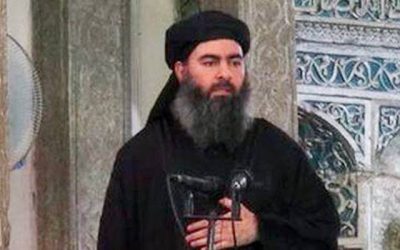ISIS Chief Al-Baghdadi Killed on Turkish Border while Fleeing Idlib

This article was completed on October 26, 2019.
Islamic State’s self-styled Caliph Abu Bakr al-Baghdadi has been killed in a United States Special Ops overnight raid Saturday involving helicopters, warplanes and a ground clash on the Turkey-Syria border while fleeing Syria’s northwestern Idlib Governorate, Reuters and Newsweek are reporting, and President Trump [has made] the major announcement of the biggest symbolic victory of his administration in the war against terrorism soon.
What’s worth noting in the news reports about the killing of al-Baghdadi is the fact that although the mainstream media had been trumpeting for the last several years that the Islamic State chief had been hiding somewhere on the Iraq-Syria border in the east, he was found hiding in the northwestern Idlib Governorate, under the control of Turkey’s militant proxies and al-Nusra Front, and was killed while trying to flee to Turkey in Brisha village on the Syria border.
Reuters reports [1]:
“Two Iraqi security sources and two Iranian officials said they had received confirmation from inside Syria that Baghdadi had been killed. ‘Our sources from inside Syria have confirmed to the Iraqi intelligence team tasked with pursuing Baghdadi that he has been killed alongside his personal bodyguard in Idlib after his hiding place was discovered when he tried to get his family out of Idlib toward the Turkish border,’ one of the Iraqi officials said.”
The reason why the mainstream media scrupulously avoided mentioning Idlib as al-Baghdadi’s most likely hideout in Syria was to cover up the collusion between the militant proxies of Turkey and the jihadists al-Nusra Front and the Islamic State. At its peak in 2014, when the Islamic State declared its “caliphate” in Mosul in Iraq and Raqqa in Syria, the Islamic State reportedly had more than 70,000 jihadists.
The divisions within the rank and file of the terrorist organization seem to be growing as it has lost all of its territory, and thousands of Islamic State’s jihadists have been killed in airstrikes conducted by the US-led coalition against the Islamic State and the ground offensives by the Iraqi armed forces and allied militias in Iraq and the Kurdish-led Syrian Democratic Forces in Syria.
Furthermore, due to frequent desertions and detention of hundreds of hardcore militants alongside thousands of innocent Arab villagers held captive by the Kurds in northeastern Syria, the number of fighters within the Islamic State’s ranks has evidently dwindled. But a question would naturally arise in the minds of perceptive observers of the war against the Islamic State in Iraq and Syria that where did the remaining tens of thousands of Islamic State’s jihadists vanish?
The riddle can be easily solved, though, if we bear in mind the fact that although Idlib Governorate in Syria’s northwest has firmly been under the control of Hayat Tahrir al-Sham (HTS) led by al-Nusra Front since 2015, its territory was equally divided between Turkey-backed rebels and al-Nusra Front.
In a brazen offensive in January, however, al-Nusra Front’s jihadists completely routed Turkey-backed militants, even though the latter were supported by a professionally trained and highly organized military of a NATO member, Turkey. And al-Nusra Front now reportedly controls more than 70% territory in the Idlib Governorate.
The reason why al-Nusra Front has been easily able to defeat Turkey-backed militants appears to be that the ranks of al-Nusra Front have now been swelled by highly motivated and battle-hardened jihadist deserters from the Islamic State after the fall of the latter’s “caliphate” in Mosul in Iraq and Raqqa in Syria.
The merger of al-Nusra Front and Islamic State in Idlib doesn’t come as a surprise, though, since the Islamic State and al-Nusra Front used to be a single organization before a split occurred between the two militant groups in April 2013 over a leadership dispute. In fact, al-Nusra Front’s chief Abu Mohammad al-Jolani was reportedly appointed [2] as the emir of al-Nusra Front by Abu Bakr al Baghdadi, the leader of Islamic State, in January 2012.
Regarding the nexus between Islamic jihadists and so-called “moderate rebels” in Syria, while the representatives of Free Syria Army (FSA) were in Washington in January last year, soliciting the Trump administration to restore the CIA’s “train and equip” program for the Syrian militants that was shuttered in July 2017, hundreds of Islamic State’s jihadists joined the moderate militants in Idlib in their battle against the advancing Syrian government troops backed by Russian airstrikes to capture the strategically important Abu Duhur airbase, according to a January last year’s AFP report [3] authored by Maya Gebeily.
The Islamic State already had a foothold in neighboring Hama province and its foray into Idlib was an extension of its outreach. The Islamic State reportedly captured several villages and claimed to have killed two dozen Syrian soldiers and taken twenty hostages. And on January 12 last year, the Islamic State officially declared Idlib one of its “Islamic emirates,” according to the aforementioned AFP report.
In all likelihood, some of the Islamic State’s jihadists who joined the battle in Idlib in January last year were part of the same contingent of thousands of Islamic State militants that fled Raqqa in October 2017 under a deal brokered [4] by the US-backed Syrian Democratic Forces (SDF).
*
Note to readers: please click the share buttons above or below. Forward this article to your email lists. Crosspost on your blog site, internet forums. etc.
Nauman Sadiq is an Islamabad-based attorney, columnist and geopolitical analyst focused on the politics of Af-Pak and Middle East regions, neocolonialism and petro-imperialism. He is a regular contributor to Global Research.
Notes
[1] Islamic State leader Baghdadi reportedly killed in Syria by U.S. forces
[2] Al-Jolani was appointed as the emir of al-Nusra Front by al-Baghdadi
[3] Four years and one caliphate later, Islamic State claims Idlib comeback
[4] Raqqa’s dirty secret: the deal that let Islamic State jihadists escape Raqqa

